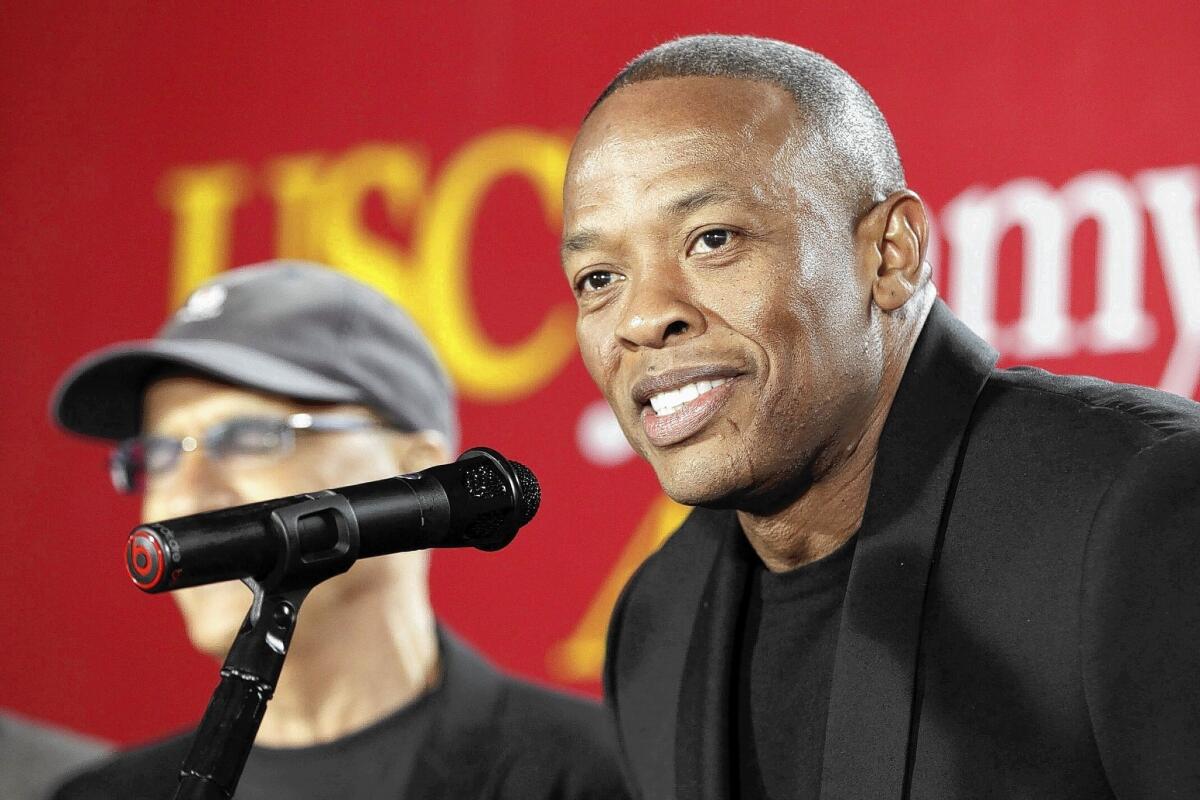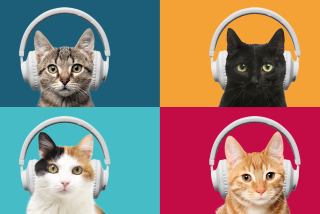Beats Music streams impressive playlists, but geeks want so much more

Got discerning taste? Interested in digging in the digital crates for the best music available in the cloud? Then you’ve no doubt been targeted by Beats Music in the past few months.
The much-hyped streaming service is the latest entry in an increasingly crowded field that includes Spotify and iTunes. It offers access to millions of songs and hundreds of hand-selected playlists for $9.99 a month (or, for ATT customers, $14.99 for a family plan).
It was unveiled last month during a big budget rollout by longtime music business executives and hitmakers Dr. Dre and Jimmy Iovine through their company, Beats Electronics. Considering their Beats by Dre brand upended the headphone market after launching in 2008, other streaming services have to be nervous.
INTERACTIVE: Discover songs of L.A.
At first blush, the app is crush-worthy, featuring playlists galore from artists including Usher, Miranda Lambert, Vampire Weekend and dozens of others, taste-making outlets and organizations including Pitchfork, XXL and Mojo and a host of in-house experts seemingly building playlists by the hour.
Offering boundless avenues to bundles of songs, the easy-to-navigate interface seems to have overcome log-in issues during the rollout that left some early adopters frustrated.
It was a rough few days, considering the competitive market for digital music portals populated by similar subscription and free services from iHeartRadio, MySpace, Rdio, Rhapsody and dozens of others. Each is claiming territory in a future in which music ownership is replaced by unlimited access to files stored on faraway servers but readily available wherever, whenever and in whatever order you so desire.
Combined with creative director Trent Reznor (Nine Inch Nails, How to Destroy Angels) and a roster of musical minds to guide you, Beats is marketing itself for its curatorial prowess and is banking that their cache and histories as innovators will lend a musicianly air to what has so far been a crowded and decidedly under-evolved streaming-music experience. Their thick Rolodexes don’t hurt.
INTERACTIVE: A festival for every fan – SoCal’s yearly sonic lineup
Curious as to what Richard Sherman was listening to while prepping for the big game? The Seahawks cornerback compiled a playlist that features rap tracks from Kendrick Lamar, Kanye West, Ace Hood, Yo Gotti and others. (His taste is as exquisite as his play.) For his part, quarterback Peyton Manning offered a collection called “There’s No ‘I’ in Peyton,” with nods to Lynyrd Skynyrd, Johnny Cash and Bob Dylan.
Stevie Nicks offers soft rock. The Academy of Country Music and the Grand Ole Opry highlight old and new twang. Top 40 guide PopCrush, hip hop realm Rap Radar and the metalheads at Revolver and Decibel aim to draw the young and obsessed. Indie haven Pitchfork offers 32 different playlists. Naxos Records spins classical through filters including “Sampled: Classical Music in Hip Hop, vol. 1.” Reissue go-to guide Mojo Magazine, jazz standby Downbeat and electronic chroniclers DJ Mag all offer fresh and resurrected sounds.
Genre tabs point to constantly updated playlists of new releases and “trending tracks,” all incredibly useful for those like me whose life revolves around fresh sounds. Browse by genre and find tips on indie, pop, electronic, kids music, comedy, country, “musica Mexicana,” new age, punk, reggae and everything else amid the millions of songs.
Though all of this is certainly a step in the right direction, Beats still hasn’t addressed the gaping hole of missing data, images and information, so it isn’t the revolution it promises to be. So far it’s the prettiest window dressing into the same 15 million to 20 million songs that most services offer, one best enjoyed on hand-held devices in range of a solid WiFi connection.
The major commitment that Beats, like Spotify and the others, has yet to make is in gathering all the informational minutiae of music. It’s hard to get lost in the wormhole of geekdom if said tunnel is only a few inches deep. For example, unlike film and TV streaming service Netflix, which breaks down films by not only genre but cross-references details on actors, movie studios, directors and links to important reviews, Beats has yet to build a similarly well-connected infrastructure, even though the service costs 20% more than Netflix a month.
Specifically, searching Queens of the Stone Age mastermind “Josh Homme” reveals vague, uninformative links to other “similar” artists (Kurt Cobain, Helmet’s Page Hamilton and Jerry Cantrell of Alice in Chains among them). In a perfect world, I’d be able to get lost searching for unfamiliar Homme moments, or happen upon strange corners through a combination of curatorial expertise and exploratory data. Why can’t I see a scan of the original packaging? Why isn’t there a “liner notes” tab where I can learn who played on which tracks?
Ideally, when I search on Trent Reznor, I’d see not only a link to Nine Inch Nails and How to Destroy Angels and accompanying liner notes, but producer and studio notes a la LP jackets and CD booklets, links to Reznor’s work in film scoring, his early contributions to work from Pigface and 1000 Homo DJs, his remixes and guest appearances. Each detail would be linked.
CRITICS’ PICKS: What to watch, where to go, what to eat
As it stands now, Reznor’s page offers bio and recommended links to soundtrack composers Howard Shore and Cliff Martinez, director John Carpenter and Nine Inch Nails. That’s it, even though a Reznor production playlist is available one step away, through the Nails page.
If I’m greedy, I’d want to know what recording studio Sly and the Family Stone used for “There’s a Riot Goin’ On.” When it lists the Village Recorder in Santa Monica, it’d be fascinating to connect it to artists and albums by Fleetwood Mac, John Mayer, Bob Dylan and Missy Elliott and the hundreds of others who have worked there.
Nitpicky, perhaps, and a very complicated undertaking. But that’s how grand innovation is built, and even if Beats’ volume of curatorial insight is indeed impressive — especially for the price — the system feels unfinished. A more deeply connected database would provide geeks of the world to use Beats’ many excellent playlists more as a springboard into the system.
The data crumbs are out there, scattered among Wiki pages, All Music Guide discography details, liner notes packaging and lyric sites, a Web waiting to be connected into a grand informational database that gathers sound and history into one grand cathedral.
-----------------------------------
Spotify
Price: $9.99 per month
Free version? Yes
Pitch: “Millions of songs at your fingertips.”
Platforms: iOS, Android, Windows
Target audience: Everyone
Rdio
Price: $9.99 per month
Free version: Yes
Pitch: Music evolved: Play and discover free.
Platforms: iOs, Android, Windows
Target audience: Independent-minded taste-makers
iHeartRadio
Price: Free
Free version: Yes
Pitch: “Listen to your favorite live radio stations or create your own commercial-free custom stations from a catalog of 18 million songs.”
Platforms: iOs, Android, Windows
Target audience: Fans of Ryan Seacrest, Clear Channel
Beats Music
Price: $9.99, or $14.99 for ATT Family plan
Free version: No
Pitch: “A new music service curated by people who believe music is emotion and life.”
Platforms: iOS, Android, Windows
Target audience: The more discerning listener, serious fans
Google Play
Price: $9.99 per month
Free version: yes (storage locker for streaming)
Pitch: “Unlimited music made easy.”
Platforms: Android
Target audience: Google devotees, Silicon Valley millionaires
Rhapsody
Price: $9.99
Free version: No
Pitch: “Listen to your favorite music, ad free.”
Platforms: iOs, Android, Windows
Target audience: Everyone
More to Read
The biggest entertainment stories
Get our big stories about Hollywood, film, television, music, arts, culture and more right in your inbox as soon as they publish.
You may occasionally receive promotional content from the Los Angeles Times.










